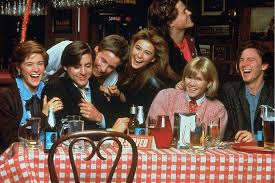In the early ‘80s, people were still making movies for folks who rarely went to movies.
Then, Andrew McCarthy recalls, logic intervened: “Hollywood discovered that: ‘Wait a minute, kids go to see a movie five, six, seven times. Grown-ups see a movie once.’”
What followed was dubbed the “Brat Pack” era; McCarthy’s documentary – arriving Thursday (June 13) on Hulu – is simply called “Brats.”.
That “brat pack” phrase – a variation on Frank Sinatra’s “rat pack” — may be unfair. It was fueled by a toxic article David Blum wrote for New York magazine in 1985, shortly before “St. Elmo’s Fire” (shown here) came out. Still, some of the people involved gradually absorbed it.
“While (Blum) acted like a scumbag, he did coin a great phrase,” Rob Lowe wrote in “Stories I Only Tell My Friends” (Henry Holt, 2011). “And so today, I own it. I’m proud to have been a leader of the pack.”
McCarthy, 61, has also mellowed, after re-meeting Blum. “I had a warmth for him that I did not anticipate,” he told the Television Critics Association.
By any name, the era was a time when Hollywood finally found its young audience.
That had started in 1977, with the sci-fi surge of “Star Wars” and “Close Encouners of the Third Kind.” Later came the dramas and comedies, including Francis Coppola’s “The Outsiders” (1983), John Hughes’ “Sisteen Candles” (1984) and “The Breakfast Club” (1985) and Joel Schumacher’s “St. Elmo’s Fire” (1985).
All drew teens. “Young people certainly feel like outsiders,” McCarthy said.
He was only in one of those four films (“St. Elmo’s Fire”), but many young actors – Lowe, Molly Ringwald, Judd Nelson, Ally Sheedy, Anthony Michael Hall – were in two. Emilion Estevez was in three.
(Shown here are, from left, Sheedy, Nelson, Estevez, Demi Moore, Lowe, Mare Winningham and McCarthy.)
Then Estevez rushed to his next project. At 23 (beating Orson Welles’ record), he was becoming the youngest person to write, direct and star in a movie.
That’s when Blum began researching a story about this new Hollywood wunderkind. Estevez, Lowe wrote, was “worried that the reporter had only seen his serious, hard-working side and (was) eager to show him that he can have fun.”
He oversucceeded. After a night with Estevez and friends, Blum switched his story. He wrote about, as Lowe put it, “pampered, spoiled, vacuous, attention-speaking actors.”
The effect was instant. “The minute the ‘brat pack’ term came into existence, everyone scattered,” McCarthy said. “I (didn’t) see Rob for 30 years.”
He did make one youth movie with Ringwald (“Pretty in Pink”) and went on to star in some hits (“Mannequin,” “Weekend at Bernie’s”) and flops. More often, he’s been busy as a writer and director, including his memoir (“Brat: An ‘80s Story”) and now “Brats.”
Were these people really brats? “I found them all to be lovely people,” McCarthy said.
They’ve had their rough moments – alcoholism for Lowe and McCarthy., pill-addiction for Sheedy, altercation arrests for Hall and Nelson. But for several, careers rebounded and lives mellowed.
When “St. Elmo’s Fire” began, McCarthy said, “I was a 22-year-old kid from New Jersey who was kicked out of college … and suddenly, I’m famous.” Brat-pack famous.

This “brat pack” gave Hollywood a youth makeover
In the early ‘80s, people were still making movies for folks who rarely went to movies.
Then, Andrew McCarthy recalls, logic intervened: “Hollywood discovered that: ‘Wait a minute, kids go to see a movie five, six, seven times. Grown-ups see a movie once.’”
What followed was dubbed the “Brat Pack” era; McCarthy’s documentary – arriving Thursday (June 13) on Hulu – is simply called “Brats.”.
That “brat pack” phrase – a variation on Frank Sinatra’s “rat pack” — may be unfair. It was fueled by a toxic article David Blum wrote for New York magazine in 1985, shortly before “St. Elmo’s Fire” (shown here) came out. Still, some of the people involved gradually absorbed it. Read more…